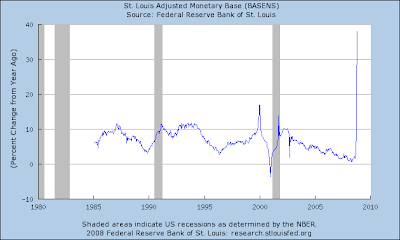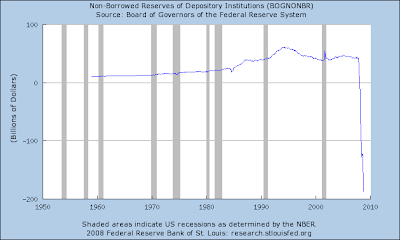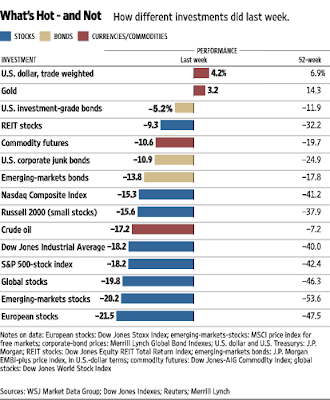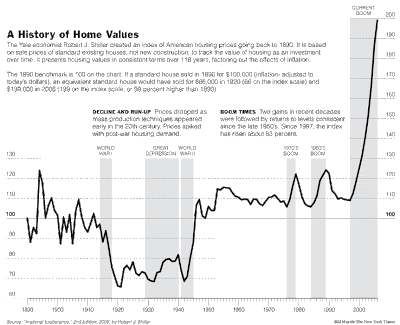I have been feeling paranoid and a little scared lately because of the speed at which recent global events have unfolded. Argentina is apparently in another crisis and is moving to seize private pension funds (see http://bloomberg.com/apps/news?pid=20601087&sid=aDuA9V2SI6GY&refer=home) and Iceland just had a financial collapse!
I want to look at the Iceland case specifically. Basically, Iceland owed too much money, then tried to nationalize their 3 major banks but the massive debts incurred by those banks exceeded the government's ability to cover the debts. If you want to be scared shitless and realize the importance of protecting your assets, just have a look at the potential parallels between Iceland and the United States.
First, a chart of the Iceland stock market (copied from the Wikipedia website):

That's a 90% loss in about a year and it's actually much worse because a currency crisis happened at the same time, which means massive inflation, so inflation-adjusted losses were close to 100% for Icelandic citizens invested in their local stock market.
How could this happen? I don't pretend to understand all the fine points of such a rapid collapse, but some crude figures frame the issue in fairly easy to understand terms. A large part of the problem was that the Iceland economy had a gross domestic product (GDP) of roughly 11 billion dollars (i.e. crudely, how much money they earn every year or their annual "income"). The Icelandic banks got into trouble with cash flows due to difficulty in rolling over/renewing short-term debt due to the credit crunch and their problems were compounded by a run on the banks by nervous (and smart) depositors.
The Icelandic government moved in to nationalize the banks, which increased the government's debt to roughly 65 billion dollars, or nearly six times the annual economic output (i.e. "income") of the country. Though a gross oversimplification to help me understand things in basic terms, the heart of the problem was too high of a debt load relative to income (sounds like a subprime or Alt-A mortgage borrower, eh?).
The United States has a gross domestic product of roughly 14-15 trillion dollars per year, much greater than Iceland, and our gross external debt was roughly 14 trillion as of June, 2008 according to Wikipedia. Our three largest banks are JP Morgan Chase, Citibank, and Bank of America. Combined, these three banks are currently holding approximately 165 trillion dollars in derivatives contracts (see page 22 of the document at http://www.occ.treas.gov/ftp/release/2008-74a.pdf for the source of this data). If we end up having to do a full bailout and nationalization of these banks, a process we have already started, our ratio of debt to GDP could be very similar to the ratio that just caused Iceland to collapse a few short weeks ago!
How do our politicians respond? By wanting to send more "stimulus" checks to anxious voters using more money we don't have and creating more debt and wanting to nationalize even more than the top 3 banks (9 largest banks at last count and the auto industry and AIG thrown into the mix just for shits and giggles). Meanwhile, U.S. citizens have very little savings in aggregate and many have learned from their government how to get in debt far beyond their ability to pay.
If you think we can't go through the same thing Iceland just did, you are fooling yourself. Not only could your investments be wiped out, your bank suddenly closed, all your money frozen, and your credit cards no longer functional, but the cash you have on hand could be rapidly depreciated away so that $50 will barely buy a loaf of bread. This has happened many times throughout history and Iceland is just the latest in a long line of examples.
What could possibly protect you in this situation? GOLD! That is why gold is an investment as well as an insurance policy. When a currency collapses, the gold price in that currency approaches infinity.
So, when you hear about the next bailout plan, the next new alphabet soup Federal Reserve lending plan, or the next stimulus package, ask yourself this basic question: How can someone who is up to their eyeballs in debt with the equivalent of 10 maxed out credit cards and an underwater mortgage loan give loans and free money out to anyone and everyone? If something fails the common sense test, maybe it's not your common sense that is at fault.
Also, do you think the citizens of Iceland were warned by their politicians in advance of the crisis so that they could prepare themselves? Which members of the Icelandic mainstream media do you think told citizens to take their money out of the stock market and out of their bank in advance of the collapse?
Do you think the government or the mainstream media will warn you in advance before the same thing happens here in the United States? Do you really believe it can't happen here? Do you think we're better than everyone else? Do you think that the U.S. can ignore a basic law of finance related to how much debt an entity can take on relative to income before that entity is unable to make good on its obligations?
Gold is money. Gold is good. Gold is insurance. Gold cannot be debased by politicians with a printing press. Gold has intrinsic value and has served as a store of wealth for thousands of years. Gold will significantly outperform the stock market for the next several years. Get some physical gold (and a little silver) and hold onto it.








































